Ketone - Study guides, Class notes & Summaries
Looking for the best study guides, study notes and summaries about Ketone? On this page you'll find 2839 study documents about Ketone.
Page 3 out of 2.839 results
Sort by

-
12. Aldehydes, Ketones and Carboxylic acids-anil-hsslive
- Exam (elaborations) • 16 pages • 2024
- Available in package deal
-
- $7.99
- + learn more
12. Aldehydes, Ketones and Carboxylic acids-anil-hsslive
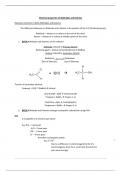
-
Chemical properties of Aldehydes and Ketones
- Exam (elaborations) • 45 pages • 2024
-
- $12.49
- + learn more
Chemical properties of Aldehydes and Ketones Reactions common to both Aldehydes and Ketones The difference between an Aldehyde and a Ketone is the position of the C=O (Carbonyl group). Aldehyde – always on a carbon at the end of the chain Ketone – Always on a carbon at middle carbon of the chain 1. BOTH Aldehydes and Ketones can be reduced Aldehyde reduced to Primary Alcohol Reducing agent = Sodium tetrahydroborate III (NaBH4) Ketone reduced to Secondary Alcohol Reduction Oxidisatio...
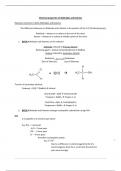
-
Chemical properties of Aldehydes and Ketones Reactions common to both Aldehydes and Ketones
- Exam (elaborations) • 45 pages • 2024
-
- $11.49
- + learn more
Chemical properties of Aldehydes and Ketones Reactions common to both Aldehydes and Ketones The difference between an Aldehyde and a Ketone is the position of the C=O (Carbonyl group). Aldehyde – always on a carbon at the end of the chain Ketone – Always on a carbon at middle carbon of the chain 1. BOTH Aldehydes and Ketones can be reduced Aldehyde reduced to Primary Alcohol Reducing agent = Sodium tetrahydroborate III (NaBH4) Ketone reduced to Secondary Alcohol Reduction Oxidisatio...

-
Chemical properties of Aldehydes and Ketones
- Exam (elaborations) • 45 pages • 2024
-
- $10.99
- + learn more
Chemical properties of Aldehydes and Ketones Reactions common to both Aldehydes and Ketones The difference between an Aldehyde and a Ketone is the position of the C=O (Carbonyl group). Aldehyde – always on a carbon at the end of the chain Ketone – Always on a carbon at middle carbon of the chain 1. BOTH Aldehydes and Ketones can be reduced Aldehyde reduced to Primary Alcohol Reducing agent = Sodium tetrahydroborate III (NaBH4) Ketone reduced to Secondary Alcohol Reduction Oxidisation ...
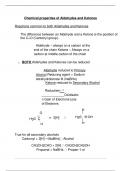
-
Chemical properties of Aldehydes and Ketones
- Exam (elaborations) • 83 pages • 2024
-
- $12.49
- + learn more
Chemical properties of Aldehydes and Ketones in of Electrons Loss of Electrons H O H3C C H + 2[H] H3C C OH H True for all secondary alcohols Carbonyl + 2[H] ─(NaBH4) Alcohol CH3CH2CHO + 2[H] CH3CH2CH2OH Propanal + NaBH4 Propan-1-ol
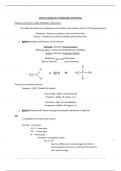
-
Chemical properties of Aldehydes and Ketones
- Exam (elaborations) • 45 pages • 2024
-
- $17.99
- + learn more
Chemical properties of Aldehydes and Ketones Reactions common to both Aldehydes and Ketones The difference between an Aldehyde and a Ketone is the position of the C=O (Carbonyl group). Aldehyde – always on a carbon at the end of the chain Ketone – Always on a carbon at middle carbon of the chain 1. BOTH Aldehydes and Ketones can be reduced Aldehyde reduced to Primary Alcohol Reducing agent = Sodium tetrahydroborate III (NaBH4) Ketone reduced to Secondary Alcohol Reduction Oxidisatio...
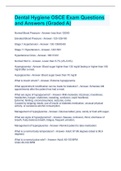
-
Dental Hygiene OSCE Exam Questions and Answers (Graded A)
- Exam (elaborations) • 6 pages • 2023
-
- $11.49
- 8x sold
- + learn more
Normal Blood Pressure - Answer- less than 120/80 Elevated Blood Pressure - Answer- 120-129/<80 Stage 1 Hypertension - Answer- 130-139/80-89 Stage 11 Hypertension - Answer- 140+/90+ Hypertensive Crisis - Answer- 180+/120+ Normal HbA1c - Answer- Lower than 5.7% (4%-5.6%) Hyperglycemia - Answer- Blood sugar higher than 130 mg/dl fasting or higher than 180 mg/dl after a meal. Hypoglycemia - Answer- Blood sugar lower than 70 mg/dl What is insulin shock? - Answer- Extreme hy...

-
Solution Manual for Organic Chemistry Mechanistic Patterns Canadian 1st Edition by Ogilvie Ackroyd Br
- Exam (elaborations) • 811 pages • 2024
-
- $19.99
- 1x sold
- + learn more
Chapter 1 Carbon and Its Compounds CHECKPOINT PROBLEMS Practice Problem 1.1 a) S — 1s2 2s2 2p6 3s2 3p4 b) Cl — 1s2 2s2 2p6 3s2 3p5 c) Na+ — 1s2 2s2 2p6 1-2 Copyright © 2018 Nelson Education Limited Practice Problem 1.2 a) Count valence electrons. Build a basic bonding framework and account for electrons used. Add remaining electrons and check for formal charges. The molecule has a lone pair on the nitrogen. All other electrons are bonding electrons. b) Count valence electrons. Build a bas...

-
NURS 5315 Advanced Pathophysiology Exam 1 Questions with Verified Answers |Latest 2024/2025
- Exam (elaborations) • 23 pages • 2024
- Available in package deal
-
- $10.99
- + learn more
What is the body's defense against ROS? Antioxidants (Vitamin E, Vitamin C, cysteine, glutathione, albumin, ceruloplasmin, transferrin) How does a hypertonic solution alter osmolality? Increases solute concentration, causing INCREASED osmolality. Causes cells to SHRINK. What lab values are elevated as we age? Interleukin 1, tumor necrosis factor-alpha, and C-reactive protein Role of hepatocytes Acetyl CoA is processed by hepatocytes and transforms to 3 ketone bodies: 1. Acetoa...
XII_Chem_New_Chap_08_Aldehydes,_Ketones_and_Carboxylic_Acids_137

How did he do that? By selling his study resources on Stuvia. Try it yourself! Discover all about earning on Stuvia



